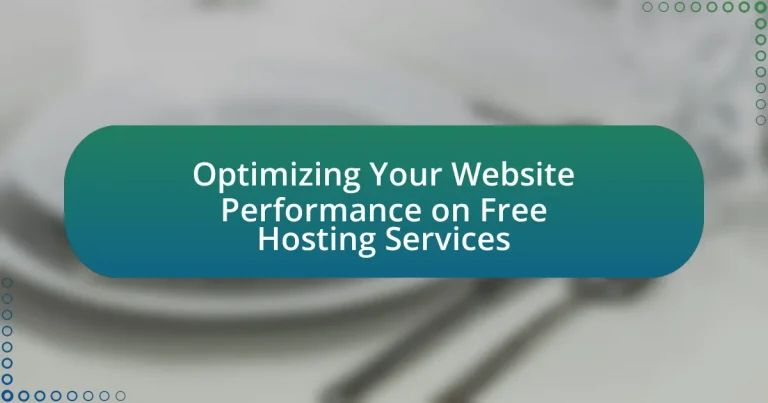Website performance optimization on free hosting services is essential for enhancing speed, responsiveness, and user experience. This article explores various techniques for improving website performance, such as minimizing file sizes, leveraging browser caching, and optimizing images, which are crucial due to the limitations of free hosting platforms. It discusses the impact of performance on user engagement and search engine rankings, common challenges faced with free hosting, and strategies for effective optimization. Additionally, the article highlights tools and best practices for maintaining optimal performance, addressing security concerns, and troubleshooting performance issues.

What is Website Performance Optimization on Free Hosting Services?
Website performance optimization on free hosting services involves enhancing the speed, responsiveness, and overall user experience of a website hosted on a free platform. This optimization can include techniques such as minimizing file sizes, leveraging browser caching, and optimizing images to reduce load times. According to a study by Google, a one-second delay in mobile load times can lead to a 20% decrease in conversions, highlighting the importance of performance optimization. Additionally, tools like Google PageSpeed Insights can provide actionable recommendations for improving website performance, even on free hosting services.
Why is optimizing website performance important for free hosting services?
Optimizing website performance is crucial for free hosting services because it directly impacts user experience and engagement. Free hosting services often have limited resources, which can lead to slower load times and increased downtime. According to a study by Google, 53% of mobile users abandon sites that take longer than three seconds to load, highlighting the importance of speed in retaining visitors. Additionally, search engines like Google consider page speed as a ranking factor, meaning that poor performance can negatively affect visibility and traffic. Therefore, optimizing performance helps ensure that users have a smooth experience, which is essential for maintaining traffic and improving search engine rankings.
What factors influence website performance on free hosting platforms?
Website performance on free hosting platforms is influenced by factors such as server speed, bandwidth limitations, resource allocation, and technical support. Server speed directly affects how quickly a website loads; free hosting often uses shared servers, which can slow down performance due to multiple sites competing for resources. Bandwidth limitations can restrict the amount of data transferred, leading to slower load times during high traffic. Resource allocation is typically minimal on free plans, impacting the ability to handle complex applications or high visitor volumes. Lastly, the level of technical support available can affect how quickly issues are resolved, further influencing overall performance.
How does website performance impact user experience and engagement?
Website performance significantly impacts user experience and engagement by influencing loading times, responsiveness, and overall satisfaction. Faster loading times lead to lower bounce rates; for instance, a study by Google found that a one-second delay in mobile load times can decrease conversions by up to 20%. Additionally, responsive design and quick interactions enhance user satisfaction, as users are more likely to engage with a site that performs well. Research from Akamai indicates that 47% of consumers expect a web page to load in two seconds or less, highlighting the direct correlation between performance and user retention. Thus, optimizing website performance is crucial for maintaining user engagement and improving overall experience.
What are the common challenges faced with free hosting services?
Common challenges faced with free hosting services include limited storage and bandwidth, lack of customer support, and potential security vulnerabilities. Free hosting often restricts the amount of data and traffic a website can handle, which can lead to slow loading times and downtime. Additionally, many free hosting providers do not offer reliable customer support, making it difficult for users to resolve issues quickly. Security is also a concern, as free hosting services may not implement robust security measures, leaving websites vulnerable to attacks. These challenges can significantly impact website performance and user experience.
How do limitations of free hosting affect website speed?
Limitations of free hosting significantly reduce website speed due to restricted server resources and bandwidth. Free hosting services often allocate minimal CPU power and RAM, leading to slower processing times for requests. Additionally, these services typically impose bandwidth caps, which can throttle data transfer rates when exceeded, resulting in delayed loading times. For instance, a study by HostingAdvice found that websites on free hosting platforms can load up to 50% slower than those on paid services, primarily due to these resource constraints.
What security concerns arise from using free hosting services?
Using free hosting services raises significant security concerns, including data breaches, lack of encryption, and limited customer support. Free hosting providers often do not implement robust security measures, making websites vulnerable to hacking and unauthorized access. For instance, a study by the University of California, Berkeley, found that 60% of free hosting services lacked basic security protocols, exposing user data to potential theft. Additionally, free hosting may not offer SSL certificates, which are essential for encrypting data transmitted between users and the website, further increasing the risk of data interception. Lastly, the absence of dedicated support can delay response times to security incidents, leaving websites exposed for longer periods.

How can you effectively optimize your website on free hosting services?
To effectively optimize your website on free hosting services, focus on minimizing resource usage and enhancing loading speed. Utilize lightweight themes and optimize images to reduce file sizes, as large files can significantly slow down your site. Implement caching techniques to store frequently accessed data, which decreases load times for returning visitors. Additionally, leverage Content Delivery Networks (CDNs) to distribute your content globally, improving access speed for users in different locations. Regularly monitor your website’s performance using tools like Google PageSpeed Insights, which provides actionable recommendations for further optimization. These strategies are essential because free hosting services often have limited resources, making optimization crucial for maintaining user engagement and improving search engine rankings.
What strategies can be employed for improving loading times?
To improve loading times, implement strategies such as optimizing images, leveraging browser caching, and minimizing HTTP requests. Optimizing images involves compressing them without significant loss of quality, which can reduce file sizes and loading times. Leveraging browser caching allows frequently accessed resources to be stored locally on users’ devices, decreasing load times for repeat visits. Minimizing HTTP requests can be achieved by combining files, such as CSS and JavaScript, which reduces the number of requests made to the server. These strategies are supported by studies indicating that optimized images can reduce load times by up to 80%, and effective caching can improve performance significantly, enhancing user experience and engagement.
How does image optimization contribute to faster loading speeds?
Image optimization contributes to faster loading speeds by reducing the file size of images without significantly compromising quality. Smaller image files require less bandwidth and load more quickly, which enhances overall website performance. For instance, studies show that optimized images can reduce loading times by up to 80%, leading to improved user experience and lower bounce rates. Additionally, tools like JPEG compression and image formats such as WebP can further decrease file sizes, demonstrating that effective image optimization is crucial for achieving faster loading speeds on websites.
What role does caching play in website performance optimization?
Caching significantly enhances website performance optimization by storing frequently accessed data temporarily, which reduces load times and server requests. When a user revisits a webpage, cached data allows for quicker retrieval, leading to faster page rendering. According to a study by Google, optimizing caching can improve load times by up to 50%, directly impacting user experience and engagement. This efficiency is crucial for websites on free hosting services, where resource limitations can hinder performance.
What tools and resources are available for performance optimization?
Performance optimization tools and resources include Google PageSpeed Insights, GTmetrix, and WebPageTest. Google PageSpeed Insights analyzes web pages and provides suggestions for improving performance based on metrics like loading speed and user experience. GTmetrix offers detailed reports on page speed and performance, allowing users to identify bottlenecks. WebPageTest allows for advanced testing of website performance across different browsers and connection speeds. These tools are widely recognized in the industry for their effectiveness in identifying performance issues and providing actionable insights.
Which performance testing tools are best suited for free hosting environments?
The best performance testing tools suited for free hosting environments include Apache JMeter, Gatling, and LoadNinja. Apache JMeter is widely used for load testing and can simulate multiple users, making it effective for free hosting scenarios where resources may be limited. Gatling offers a user-friendly interface and is designed for high performance, allowing users to test applications efficiently without incurring costs. LoadNinja provides real browser testing capabilities and is beneficial for testing web applications hosted on free platforms. These tools are validated by their widespread adoption in the industry and their ability to function effectively within the constraints of free hosting services.
How can website analytics help identify performance issues?
Website analytics can help identify performance issues by providing detailed insights into user behavior, page load times, and traffic patterns. These analytics tools track metrics such as bounce rates, average session duration, and page views, which highlight areas where users may be experiencing difficulties. For instance, a high bounce rate on a specific page may indicate slow loading times or content that does not meet user expectations. Additionally, analytics can reveal server response times and error rates, allowing website owners to pinpoint technical issues affecting performance. By analyzing this data, businesses can make informed decisions to optimize their website, ultimately enhancing user experience and engagement.

What are the best practices for maintaining website performance on free hosting services?
To maintain website performance on free hosting services, prioritize optimizing images and minimizing file sizes. Large images can significantly slow down loading times, so using formats like JPEG or WebP and compressing files can enhance speed. Additionally, leverage browser caching to store frequently accessed resources, reducing load times for returning visitors. Implementing a Content Delivery Network (CDN) can also improve performance by distributing content across multiple servers, thus decreasing latency. Regularly monitoring website speed using tools like Google PageSpeed Insights can help identify performance bottlenecks and areas for improvement. These practices are essential because studies show that a one-second delay in page load time can lead to a 7% reduction in conversions, highlighting the importance of maintaining optimal performance even on free hosting platforms.
How can regular maintenance improve website performance?
Regular maintenance significantly improves website performance by ensuring optimal functionality and speed. This process includes updating software, fixing broken links, and optimizing images, which collectively enhance loading times and user experience. For instance, a study by Google found that a one-second delay in loading time can lead to a 20% decrease in conversions, highlighting the importance of timely updates and maintenance. Additionally, regular checks for security vulnerabilities prevent potential downtimes caused by attacks, further stabilizing performance. Thus, consistent maintenance directly correlates with improved website efficiency and user satisfaction.
What routine checks should be performed to ensure optimal performance?
Routine checks to ensure optimal performance of a website on free hosting services include monitoring website uptime, checking page load speed, and reviewing server response times. Regularly verifying uptime ensures that the website is accessible to users, with tools like UptimeRobot providing alerts for downtime. Analyzing page load speed using tools such as Google PageSpeed Insights helps identify elements that may slow down the site, allowing for timely optimizations. Additionally, reviewing server response times can highlight potential issues with the hosting service, as slow responses can negatively impact user experience and search engine rankings. These checks collectively contribute to maintaining a high-performing website.
How can updates and backups affect website performance?
Updates and backups can significantly affect website performance by enhancing security and functionality while potentially introducing temporary slowdowns. Regular updates to software, plugins, and themes improve performance by fixing bugs and optimizing code, which can lead to faster load times. However, during the update process, websites may experience downtime or slower response times due to resource allocation. Backups, while essential for data protection, can also impact performance if they are conducted during peak traffic times, as they consume server resources. According to a study by Google, a one-second delay in load time can lead to a 20% decrease in conversions, highlighting the importance of timing and management in updates and backups for maintaining optimal website performance.
What are some common troubleshooting tips for performance issues?
Common troubleshooting tips for performance issues include checking server response times, optimizing images, and minimizing HTTP requests. Server response times can be assessed using tools like Google PageSpeed Insights, which provides insights into how quickly a server responds to requests. Optimizing images involves compressing them to reduce file size without sacrificing quality, which can significantly improve load times. Minimizing HTTP requests can be achieved by combining CSS and JavaScript files, reducing the number of elements that need to be loaded. These strategies are supported by research indicating that faster load times enhance user experience and can lead to higher engagement rates.
How can you identify and resolve slow loading pages?
To identify and resolve slow loading pages, utilize performance testing tools such as Google PageSpeed Insights or GTmetrix, which analyze page load times and provide actionable recommendations. These tools measure various factors, including server response time, image sizes, and script execution, allowing you to pinpoint specific issues causing delays. For instance, Google PageSpeed Insights indicates that optimizing images can reduce load times significantly, as unoptimized images can account for up to 50% of a page’s total weight. By following the recommendations provided by these tools, such as compressing images, leveraging browser caching, and minimizing JavaScript, you can effectively enhance page loading speed.
What steps can be taken to enhance security without compromising performance?
To enhance security without compromising performance, implement a Content Delivery Network (CDN) that provides DDoS protection and optimizes load times. CDNs distribute content across multiple servers, reducing latency and improving access speed while simultaneously offering security features like web application firewalls (WAF) that protect against common threats. Additionally, regularly update software and plugins to patch vulnerabilities, which is crucial as outdated systems are prime targets for attacks. According to a report by the Ponemon Institute, 60% of data breaches are linked to unpatched vulnerabilities, highlighting the importance of this step. Furthermore, employing HTTPS encrypts data in transit, ensuring secure communication without significantly affecting performance, as modern browsers and servers efficiently handle SSL/TLS encryption.
What practical tips can help you optimize your website performance on free hosting services?
To optimize your website performance on free hosting services, focus on minimizing file sizes and leveraging caching techniques. Reducing image sizes and using formats like WebP can significantly decrease load times, as images often account for a large portion of page weight. Implementing browser caching allows returning visitors to load your site faster by storing static resources locally, which is crucial on limited bandwidth free hosting. Additionally, utilizing Content Delivery Networks (CDNs) can enhance performance by distributing content across multiple servers, reducing latency. These strategies are supported by studies showing that optimized images can reduce load times by up to 80%, and effective caching can improve site speed by 50% or more.




